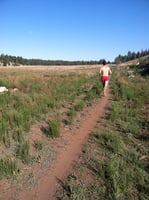(Original Post Date: 4/5/23)
Train Smart - What a Running Specialist PT Wished all Runners Knew - Acute: Chronic Workload Ratio
(Original Post Date: 9/22/22)
Overuse injuries are the most common running-related injuries. These include tendinopathies, bone stress injuries, IT Band Syndrome, Patellofemoral Syndrome, plantar fasciitis, Greater Trochanteric Pain Syndrome, etc.
Why do overuse injuries happen? The answer is simple: the involved tissues get more stress than they are able to handle.
There are 3 potential components to why the tissues get overloaded, and therefore 3 potential components to emphasize when trying to prevent or treat overuse injuries.
- Strength limitations
- Mobility limitations
- Training errors
Strength Limitations
Your muscles, tendons, and bones may not be strong enough for the demands you are placing on them. This can be directly at the source of the injury, or elsewhere in your body causing a compensatory effect. The fix? Find your unique limitations and get stronger in these areas through strength training and plyometrics.
Mobility Limitations
Your joints and muscles may not have enough mobility/flexibility, placing more stress on other joints, bones, muscles, or tendons. The fix? Find your unique limitations and improve your mobility in these areas through joint stretches, muscle stretches, and loading into these restricted ranges.
Training Errors
Many physical therapists & chiropractors can help you determine your strength and mobility limitations and prescribe exercises to address these issues. That’s what we learn in school. But here’s the BIGGIE. Most health professionals don’t know how to work with runners. They tell you to stop running, or run way less, and leave it at that. That’s because they never learned about running in school, and if they’ve never defined themselves as a runner they’re not likely to understand the third (and usually most important) component of preventing & treating running-related overuse injuries.
Here’s why training errors are the most important. You can run without pain and have huge limitations in strength and mobility. It just might not be the frequency, intensity, duration, or type of running that you want to be able to do.
You could also have no definitive strength or mobility limitations, and still get injured. This is common and is usually associated with doing too much too soon & large changes in training frequency, intensity, or volume. Your tissues adapt to the stress that is placed on them. If you stress them more than they are accustomed to, even if they are relatively strong, there is a potential for overload.
The good news is that we can track these loads carefully to decrease the likelihood of injury.
Most runners have kept a mileage log at one point. Great! This gives us a general idea of the ground reaction (pounding) forces on our legs. The 10% rule for increasing mileage is commonly adhered to by runners and coaches, even though there have been studies showing no difference in injury risk between groups following a 10% increase rule and groups following a 25% increase rule (Damsted et al 2018). In both groups, 20% of the runners sustained an injury over the course of the 8-week study.
Why is that? The only logical answer is that there must be much more to injury rates than just how far/long you are running. Let’s dig deep into that!
Rate of Perceived Exertion (RPE)
After each run you rate the amount of total exertion your body feels from 1 to 10. 1 is minimal exertion, 10 is maximal exertion.
The great thing about RPE is that it takes numerous things into account, including recovery status, fatigue, sleep quality, stress levels, hormonal changes, nutrition, hydration, muscle soreness, weather, elevation, etc. None of these are tracked when we only look at weekly mileage!
Session RPE (sRPE)
Once you record your RPE for the run, you can do some calculations to determine your session RPE for both distance and time.
Run distance session RPE (DsRPE) = distance of the run X RPE.
Run time session RPE (TsRPE) = duration of the run X RPE.
For each day that you run, you get a DsRPE and TsRPE. These are measured in arbitrary units (A.U.). Add these up for each week and you can really start to do more valuable calculations to help determine your risk of injury.
Acute: Chronic Workload Ratio (ACWR)
ACWR makes it possible to verify whether the loads previously imposed (chronic) were sufficient for the load to be exposed (acute). This can be done for both DsRPE and TsRPE.
To calculate ACWR for DsRPE, take the current week’s DsRPE (Accumulated Load - Distance) and divide it by the average DsRPE for the last 4 weeks.
Studies have found the “sweet spot” ACWR range to be between 0.8-1.3, with values of 1.5 suggesting a 29% increase risk of sustaining an injury and values above 1.6 suggesting a 3-5 times greater injury risk.
But that’s a lot of math. Luckily for you, I have developed a training log template on excel. You enter 3 values each day (run distance, run time, and RPE) and the rest of the calculations are automatic! I want to make it as easy as possible for you to avoid running-related injuries. I am a firm believer in the ACWR Training Log to provide runners with appropriate data to make more informed training decisions.
If you're interested in receiving a copy of our ACWR Training Log Template, send me an email at kelton@steadystatehealth.com.
If you’ve got a running-related overuse injury you can waste a lot of time trying to learn how to address these 3 components of tissue overload on your own, delaying the time until you’re able to run without pain.
Or you can hire a running specialist to tell you exactly what you need to do to get back to pain-free running ASAP. We provide running-specific physical therapy assessments, run coaching, and strength coaching - working with injured and non-injured runners alike.
We always offer free phone consults to help determine what your next steps should be and whether we think we can help you or not. Reach out to us on any platform to get started!




